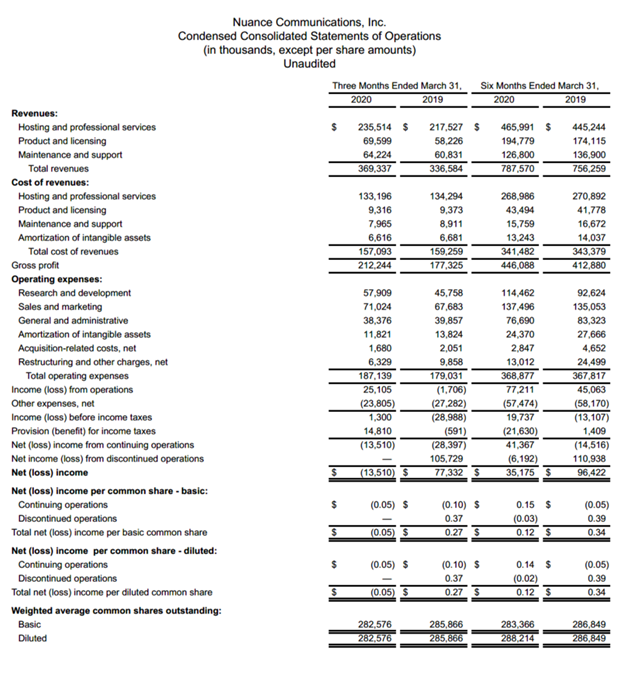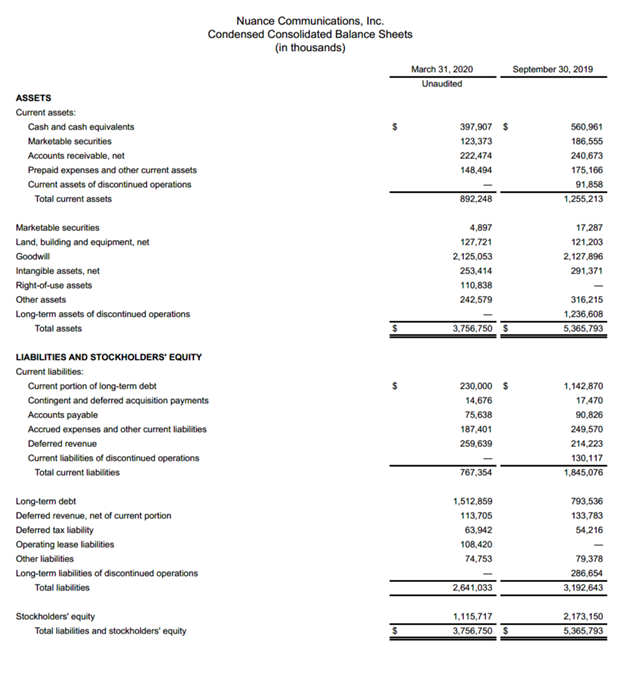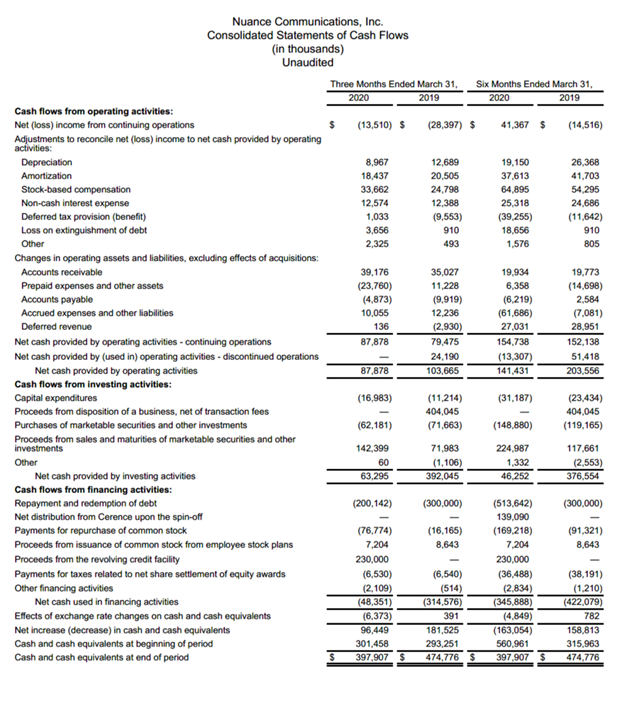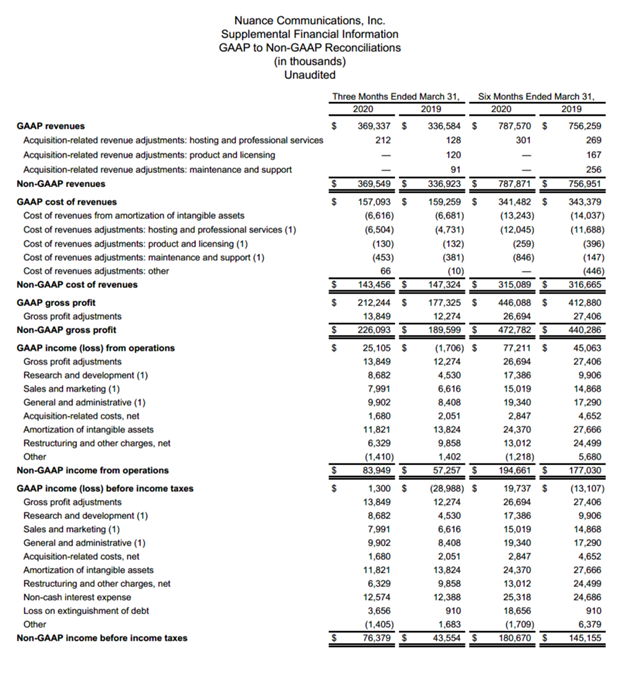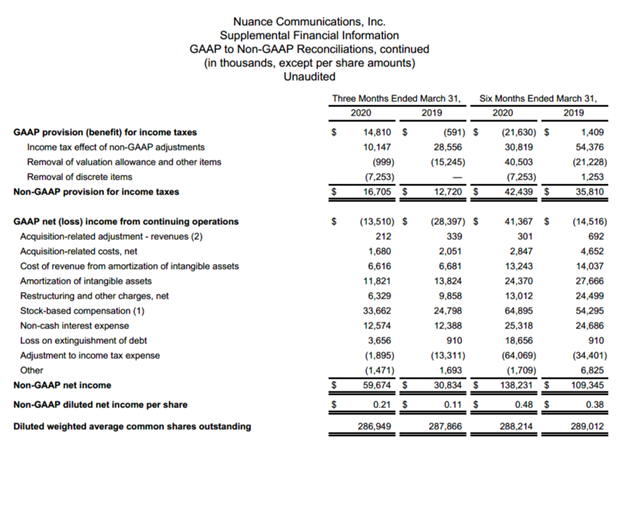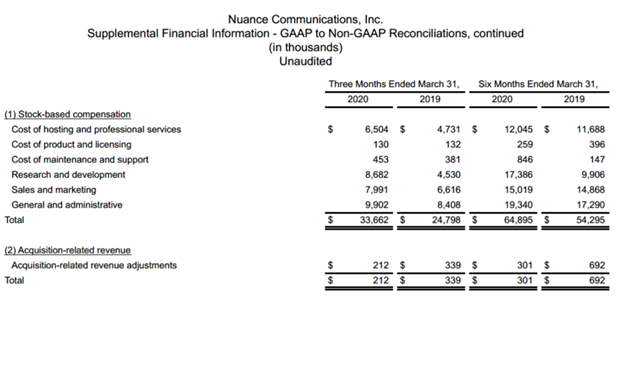BURLINGTON, Mass., May 7, 2020 - Nuance Communications, Inc. (NASDAQ: NUAN) today announced financial results for its second quarter ended March 31, 2020.
Q2 2020 Performance Summary
• GAAP revenue of $369.3 million and GAAP earnings per diluted share of $(0.05).
• Non-GAAP revenue of $369.5 million and non-GAAP earnings per diluted share of $0.21.
“Despite COVID-19, we had another excellent quarter, with revenue and EPS exceeding the high end of our guidance,” said Mark Benjamin, Chief Executive Officer at Nuance. “We achieved 11% year-over-year organic revenue growth, with strength from both our Healthcare and Enterprise segments. Enterprise reported 19% annual revenue growth, the highest in 10 years, driven by our Intelligent Engagement solutions. Healthcare revenue grew 10% year-over-year, driven by strong growth in Dragon Medical cloud and increased demand from our newer cloud-based solutions, PowerScribe One and CDE One.
In line with our capital allocation focus, we repurchased 3.8 million shares of common stock and paid down $170 million of debt during the quarter. This occurred before these programs were put on hold in March when the COVID-19 pandemic escalated. We ended the quarter with a strong cash position and remain confident in the resiliency of our highly recurring business model.
Given our compelling financial and operating position, we fully expect to weather the disruption of this pandemic. However, we also expect a near-term impact on our business, particularly within Healthcare, given the significant reduction in elective procedures and the reprioritization of initiatives by hospitals to focus on COVID-19. As such, we have revised our full-year guidance.
Despite the uncertain near-term operating environment, I believe the markets we serve will expand post COVID-19 as our customers appreciate the critical need for AI-based solutions, remote access capabilities for healthcare workers, and increased demand for telehealth, and security and fraud protection solutions. We remain an incredibly resilient company, and I am confident that we will emerge from this pandemic stronger.”
Q2 2020 Performance Summary
Q2 2020 results for continuing operations include:
• Revenue of $369.3 million, compared to $336.6 million in the same period last year.
• Non-GAAP revenue of $369.5 million, compared to $336.9 million in the same period last year.
• Organic revenue growth of 11% compared to the same period last year.
• GAAP EPS of $(0.05), compared to $(0.10) in the same period last year.
• Non-GAAP EPS of $0.21, compared to $0.11 in the same period last year.
• GAAP net loss of $13.5 million, compared to a net loss of $28.4 million in the same period last year.
• Non-GAAP net income of $59.7 million, compared to $30.8 million in the same period last year.
• GAAP operating margin of 6.8%, compared to (0.5)% in the same period last year.
• Non-GAAP operating margin of 22.7%, compared to 17.0% in the same period last year.
• Operating cash flows from continuing operations was $87.9 million, compared to $79.5 million in the same period last year.
Capital Allocation
In the second quarter of 2020, we repurchased approximately 3.8 million shares of common stock at an average price of $20.40 per share for total consideration of $76.8 million. From the beginning of the fiscal year through March 31, 2020, the Company repurchased a total of 9.5 million shares of its common stock, at an average price of $17.89 per share, for aggregate consideration of $169.2 million. As of March 31, 2020, there was $261.2 million available under our existing authorization for share repurchases.
During the second quarter of fiscal year 2020, we also repurchased $87.3 million of 2025 convertible debentures, $36.5 million 2035 convertible debentures, and redeemed the remaining $46.6 million of the 2031 convertible debentures. In addition, in an effort to protect our financial strength as the COVID-19 pandemic escalated, we drew $230 million from our revolving credit facility. This brought our total cash and marketable securities balance to approximately $526 million at quarter end.
For a complete discussion of Nuance’s results and business outlook, please see the Company’s Prepared Remarks document available at http://www.nuance.com/earnings-results/.
Please refer to the “Discussion of Non-GAAP Financial Measures,” and “GAAP to Non-GAAP Reconciliations,” included elsewhere in this release, for more information regarding the Company’s use of non-GAAP financial measures.
Conference Call and Prepared Remarks
Nuance will host a conference call today at 5:00 p.m. ET. To participate, please access the live webcast here, or dial (877) 273-6124 (US and Canada) or (647) 689-5393 (international) and reference code 9089263.
Nuance will provide a copy of Prepared Remarks in combination with its press release. These remarks are offered to provide shareholders and analysts additional detail for analyzing the results. The remarks are available at http://investors.nuance.com/ and will not be read on the call.
About Nuance Communications, Inc.
Nuance Communications (NASDAQ: NUAN) is the pioneer and leader in conversational AI innovations that bring intelligence to everyday work and life. The company delivers solutions that understand, analyze, and respond to people – amplifying human intelligence to increase productivity and security. With decades of domain and AI expertise, Nuance works with thousands of organizations globally across healthcare, financial services, telecommunications, government, and retail – to create stronger relationships and better experiences for their customers and workforce. For more information, please visit www.nuance.com.
Trademark reference: Nuance and the Nuance logo are registered trademarks or trademarks of Nuance Communications, Inc. or its affiliates in the United States and/or other countries. All other trademarks referenced herein are the property of their respective owners.
Safe Harbor and Forward-Looking Statements
Statements in this document regarding future performance and our management’s future expectations, beliefs, goals, plans or prospects constitute forward-looking statements within the meaning of the Private Securities Litigation Reform Act of 1995. Any statements that are not statements of historical fact (including statements containing the words “believes,” “plans,” “anticipates,” “expects,” "intends" or “estimates” or similar expressions) should also be considered to be forward-looking statements. There are a number of important factors that could cause actual results or events to differ materially from those indicated by such forward- looking statements, including but not limited to: the impact of the COVID-19 pandemic, the effects of competition, including pricing pressure, and changing business models in the markets and industries in which we operate; fluctuations in demand for our existing and future products; changes to economic, political, and regulatory conditions in the United States and internationally; our ability to attract and retain key personnel; further unanticipated costs resulting from our FY17 malware incident including potential costs associated with governmental investigations that may result from the incident; our ability to control and successfully manage our expenses and cash position; potential future cybersecurity and data privacy incidents or breaches; our ability to comply with applicable domestic and international laws and policies; fluctuating currency rates; possible quality issues in our products and technologies; our ability to realize anticipated synergies from acquired businesses, to cut stranded costs related to divested businesses, and to capture the expected value from strategic transactions including the spin-off of our Automotive business; and the other factors described in our most recent Form 10-K, Form 10-Q and other filings with the Securities and Exchange Commission. We disclaim any obligation to update any forward-looking statements as a result of developments occurring after the date of this document.
Discussion of non-GAAP Financial Measures
We believe that providing non-GAAP ("Generally Accepted Accounting Principles") information to investors, in addition to the GAAP presentation, allows investors to view the financial results in the way management views the operating results. We further believe that providing this information allows investors not only to better understand our financial performance, but more importantly, to evaluate the efficacy of the methodology and information used by management to evaluate and measure such performance. The non-GAAP information included in this press release should not be considered superior to, or a substitute for, financial statements prepared in accordance with GAAP.
We utilize a number of different financial measures, both GAAP and non-GAAP, in analyzing and assessing the overall performance of the business, for making operating decisions and for forecasting and planning for future periods. Our annual financial plan is prepared both on a GAAP and non-GAAP basis, and the non-GAAP annual financial plan is approved by our board of directors. Continuous budgeting and forecasting for revenue and expenses are conducted on a consistent non-GAAP basis (in addition to GAAP) and actual results on a non-GAAP basis are assessed against the non-GAAP annual financial plan. The board of directors and management utilize these non-GAAP measures and results (in addition to the GAAP results) to determine our allocation of resources. In addition, and as a consequence of the importance of these measures in managing the business, we use non-GAAP measures and results in the evaluation process to establish management’s compensation. For example, our annual bonus program payments are based upon the achievement of consolidated non-GAAP revenue and consolidated non-GAAP earnings per share financial targets. We consider the use of non-GAAP revenue helpful in understanding the performance of our business, as it excludes the purchase accounting impact on acquired deferred revenue and other acquisition-related adjustments to revenue. We also consider the use of non-GAAP earnings per share helpful in assessing the organic performance of the continuing operations of our business. By organic performance we mean performance as if we had owned an acquired business in the same period a year ago. By constant currency organic performance, we mean performance excluding the effect of current foreign currency rate fluctuations. By continuing operations, we mean the ongoing results of the business excluding certain unplanned costs. While our management uses these non-GAAP financial measures as a tool to enhance their understanding of certain aspects of our financial performance, our management does not consider these measures to be a substitute for, or superior to, the information provided by GAAP financial statements.
Consistent with this approach, we believe that disclosing non-GAAP financial measures to the readers of our financial statements provides such readers with useful supplemental data that, while not a substitute for GAAP financial statements, allows for greater transparency in the review of our financial and operational performance. In assessing the overall health of the business during the three months ended March 31, 2020 and 2019, our management has either included or excluded items in seven general categories, each of which is described below.
Acquisition-related revenue and cost of revenue.
We provide supplementary non-GAAP financial measures of revenue that include revenue that we would have recognized but for the purchase accounting treatment of acquisition transactions. Non-GAAP revenue also includes revenue that we would have recognized had we not acquired intellectual property and other assets from the same customer. Because GAAP accounting requires the elimination of this revenue, GAAP results alone do not fully capture all of our economic activities. These non-GAAP adjustments are intended to reflect the full amount of such revenue. We include non-GAAP revenue and cost of revenue to allow for more complete comparisons to the financial results of historical operations, forward-looking guidance and the financial results of peer companies. We believe these adjustments are useful to management and investors as a measure of the ongoing performance of the business because, although we cannot be certain that customers will renew their contracts, we have historically experienced high renewal rates on maintenance and support agreements and other customer contracts. Additionally, although acquisition-related revenue adjustments are non-recurring with respect to past acquisitions, we generally will incur these adjustments in connection with any future acquisitions.
Acquisition-related costs, net.
In recent years, we have completed a number of acquisitions, which result in operating expenses, that would not otherwise have been incurred. We provide supplementary non-GAAP financial measures, which exclude certain transition, integration and other acquisition-related expense items resulting from acquisitions, to allow more accurate comparisons of the financial results to historical operations, forward looking guidance and the financial results of less acquisitive peer companies. We consider these types of costs and adjustments, to a great extent, to be unpredictable and dependent on a significant number of factors that are outside of our control. Furthermore, we do not consider these acquisition-related costs and adjustments to be related to the organic continuing operations of the acquired businesses and are generally not relevant to assessing or estimating the long-term performance of the acquired assets. In addition, the size, complexity and/or volume of past acquisitions, which often drives the magnitude of acquisition related costs, may not be indicative of the size, complexity and/or volume of future acquisitions. By excluding acquisition-related costs and adjustments from our non-GAAP measures, management is better able to evaluate our ability to utilize our existing assets and estimate the long-term value that acquired assets will generate for us. We believe that providing a supplemental non-GAAP measure, which excludes these items allows management and investors to consider the ongoing operations of the business both with, and without, such expenses.
These acquisition-related costs fall into the following categories: (i) transition and integration costs; (ii) professional service fees and expenses; and (iii) acquisition-related adjustments. Although these expenses are not recurring with respect to past acquisitions, we generally will incur these expenses in connection with any future acquisitions. These categories are further discussed as follows:
(i) Transition and integration costs. Transition and integration costs include retention payments, transitional employee costs, and earn-out payments treated as compensation expense, as well as the costs of integration-related activities, including services provided by third parties.
(ii) Professional service fees and expenses. Professional service fees and expenses include financial advisory, legal, accounting and other outside services incurred in connection with acquisition activities, and disputes and regulatory matters related to acquired entities.
(iii) Acquisition-related adjustments. Acquisition-related adjustments include adjustments to acquisition-related items that are required to be marked to fair value each reporting period, such as contingent consideration, and other items related to acquisitions for which the measurement period has ended, such as gains or losses on settlements of pre-acquisition contingencies.
Amortization of acquired intangible assets.
We exclude the amortization of acquired intangible assets from non-GAAP expense and income measures. These amounts are inconsistent in amount and frequency and are significantly impacted by the timing and size of acquisitions. Providing a supplemental measure which excludes these charges allows management and investors to evaluate results “as-if” the acquired intangible assets had been developed internally rather than acquired and, therefore, provides a supplemental measure of performance in which our acquired intellectual property is treated in a comparable manner to our internally developed intellectual property. Although we exclude amortization of acquired intangible assets from our non-GAAP expenses, we believe that it is important for investors to understand that such intangible assets contribute to revenue generation. Amortization of intangible assets that relate to past acquisitions will recur in future periods until such intangible assets have been fully amortized. Future acquisitions may result in the amortization of additional intangible assets.
Non-cash expenses.
We provide non-GAAP information relative to the following non-cash expenses: (i) stock-based compensation; and (ii) non-cash interest. These items are further discussed as follows:
(i) Stock-based compensation. Because of varying valuation methodologies, subjective assumptions and the variety of award types, we believe that excluding stock-based compensation allows for more accurate comparisons of operating results to peer companies, as well as to times in our history when stock-based compensation was more or less significant as a portion of overall compensation than in the current period. We evaluate performance both with and without these measures because compensation expense related to stock-based compensation is typically non-cash and the options and restricted awards granted are influenced by the Company’s stock price and other factors such as volatility that are beyond our control. The expense related to stock-based awards is generally not controllable in the short-term and can vary significantly based on the timing, size and nature of awards granted. As such, we do not include such charges in operating plans. Stock-based compensation will continue in future periods.
(ii) Non-cash interest. We exclude non-cash interest because we believe that excluding this expense provides senior management, as well as other users of the financial statements, with a valuable perspective on the cash-based performance and health of the business, including the current near-term projected liquidity. Non-cash interest expense will continue in future periods.
Other expenses.
We exclude certain other expenses that result from unplanned events outside the ordinary course of continuing operations, in order to measure operating performance and current and future liquidity both with and without these expenses. By providing this information, we believe management and the users of the financial statements are better able to understand the financial results of what we consider to be our organic, continuing operations. Included in these expenses are items such as restructuring charges, asset impairments and other charges (credits), net, and losses from extinguishing our convertible debt. Other items such as consulting and professional services fees related to assessing strategic alternatives and our transformation programs, implementation of the new revenue recognition standard (ASC 606), and expenses associated with the malware incident and remediation thereof are also excluded.
Non-GAAP income tax provision.
Our non-GAAP income tax provision is determined based on our non-GAAP pre-tax income. The tax effect of each non-GAAP adjustment, if applicable, is computed based on the statutory tax rate of the jurisdiction to which the adjustment relates. Additionally, as our non-GAAP profitability is higher based on the non-GAAP adjustments, we adjust the GAAP tax provision to remove valuation allowances and related effects based on the higher level of reported non-GAAP profitability. We also exclude from our non-GAAP tax provision certain discrete tax items as they occur.
Contact Information
For Investors
Tracy Krumme
Nuance Communications, Inc.
Tel: 781-565-4334
Email: tracy.krumme@nuance.com
For Press
Nancy Scott
Nuance Communications, Inc.
Tel: 781-565-4130
Email: nancy.scott@nuance.com
Financial Tables Follow
